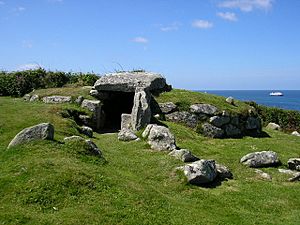Bant's Carn facts for kids
Bant's Carn is an ancient burial place from the Bronze Age. It's called an "entrance grave" and is found on the island of St Mary's in the Isles of Scilly, England. This tomb is one of the best examples of these special graves found in the Scilly Isles. Just below Bant's Carn, you can find the remains of an Iron Age village called Halangy Down.
What is Bant's Carn?
Bant's Carn sits on a sloping hill on St Mary's island. Below it are the remains of the ancient village of Halangy Down. The tomb itself is about 8 meters (26 feet) wide. It stands on a low platform that is about 12 meters (39 feet) across.
The entrance to the tomb is about 4.5 meters (15 feet) long and 1 meter (3 feet) high. It doesn't have a roof. A stone doorway separates the entrance from the main burial room. This room is about 5 meters (16 feet) long and 1.5 meters (5 feet) wide and high. Four large flat stones act as its roof. The whole structure is partly surrounded by the platform, which leads to the tomb's entrance.
History of Bant's Carn
The Isles of Scilly were first settled a very long time ago, around 2500 BC. This was during the Neolithic period, also known as the New Stone Age. Burial sites on the islands date from the late Neolithic period to the Middle Bronze Age (2500-1000 BC).
More than eighty "entrance graves" have been found on the Isles of Scilly. Most of these graves were built in the Middle Bronze Age, between 1500 and 1000 BC. Bant's Carn is a great example of this type of grave. When archaeologists dig up these graves, they often find human remains, special pots called cremation urns, and pieces of pottery.
Discoveries at the Tomb
The tomb was first dug up in 1900 by an archaeologist named George Bonsor. He found the tomb mostly empty. However, he did find some cremated human remains at the very back of the chamber. He also found pieces of Neolithic and Bronze Age pottery.
Later, in 1970, some restoration work was done on the tomb. This work was led by P. Ashbee. During this time, they put back one of the large roof stones and a stone at the entrance. They also found 140 decorated pieces of ancient pottery near the entrance stone. Two worked flints were also found. These items were given to the Isles of Scilly Museum in 1976.
George Bonsor never officially published what he found during his digs on Scilly. In 1926, his friend T.D. Kendrick, who worked at the British Museum, visited him. Kendrick learned that Bonsor had kept all his notes, drawings, and finds from his work on Scilly. Kendrick convinced Bonsor to send some of the items to the British Museum. After Bonsor passed away, his important plans and drawings were also given to the museum. These plans were very helpful when Bant's Carn was restored in 1970.
The area around Bant's Carn also has remains of old field systems and other settlements from more recent times. Today, Bant's Carn and the nearby Iron Age village of Halangy Down are looked after by English Heritage. There's also an old military building from 1905 nearby.



